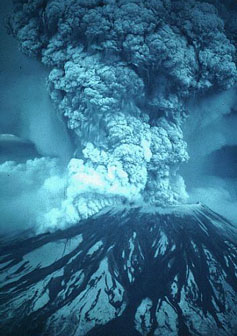A volcano is generally a conical shaped hill or mountain built by accumulations of lava flows, tephra, and volcanic ash. About 95% of active volcanoes occur at the plate subduction zones and at the mid-oceanic ridges (Figure 10n-1). The other 5% occur in areas associated with lithospheric hot spots. These hot spots have no direct relationships with areas of crustal creation or subduction zones. It is believed that hot spots are caused by plumes of rising magma that have their origin within the asthenosphere.

| Figure 10n-1: Location of the Earth's major volcanoes. Most occur along tectonic plate boundaries where plate subduction creates rising plumes of magma. The volcanoes that do not occur along plate boundaries are the result of localized asthenosphere hot spots that melt through the Earth's crust. The Hawaiian Island chain of volcanoes was create by a hot spot. |
Over the last 2 million years, volcanoes have been depositing lava, tephra, and ash in particular areas of the globe (Figure 10n-2). These areas occur at hot spots, rift zones, and along plate boundaries where tectonic subduction is taking place.

| Figure 10n-2: Location of major volcanic deposits laid down during the last 2 million years. |
Not all volcanoes are the same. Geologists have classified five different types of volcanoes. This classification is based on the geomorphic form, magma chemistry, and the explosiveness of the eruption.
The least explosive type of volcano is called a basalt plateau. These volcanoes produce a very fluid basaltic magma with horizontal flows. The form of these volcanoes is flat to gently sloping and they can occupy an area from 100,000 to 1,000,000 square kilometers. Deposits of these volcanoes can be as thick as 1800 meters. Large basalt plateaus are found in the Columbia River Plateau, western India, northern Australia, Iceland, Brazil, Argentina, and Antarctica.
Some basaltic magmas can produce very large slightly sloping volcanoes, 6 to 12°, that have gently flowing magmas called shield volcanoes. Shield volcanoes can be up to 9000 meters tall. The volcanoes of the Hawaiian Islands are typical of this type. Extruded materials from this type of volcano mainly consist of low viscosity basaltic lava flows (Figure 10n-3).

| Figure 10n-3: Low viscosity basaltic lava flow. (Source: U.S. Geological Survey) |
A cinder cone is a small volcano, between 100 and 400 meters tall, made up of exploded rock blasted out of a central vent at a high velocity (Figure 10n-4). These volcanoes develop from magma of basaltic to intermediate composition (andesite). They form when large amounts of gas accumulate within rising magma. Examples of cider cones include Little Lake Volcano in California and Paricutin Volcano in Mexico.

| Figure 10n-4: Cinder cone volcano in the Mojave National Preserve, California. (Source: U.S. Geological Survey) |
Composite volcanoes are made from alternate layers of lava flows and exploded rock. Their height ranges from 100 to 3500 meters tall. The chemistry of the magma of these volcanoes is quite variable ranging from basalt to granite. Magmas that are more granitic tend to be very explosive because of their relatively higher water content. Water at high temperatures and pressures is extremely volatile. Examples of composite volcanoes include Italy's Vesuvius, Japan's Mount Fuji, and Washington State's Mount Rainier and Mount St. Helens (see Figures 10n-5 and 10n-6).

| Figure 10n-5: Mount St. Helens eruption on May 18, 1980. (Source: U.S. Geological Survey, photograph by Austin Post). |

| Figure 10n-6: The above image is a post-eruption computer rendering of Mount St. Helens from a U.S.Geological Survey digital elevation model (DEM). The lateral eruption removed 2.8 cubic kilometers of rock and sediment from from the volcano and lowered its height by 400 meters. Detectable amounts of ash were spread over 50,000 square kilometers of area surrounding the volcano. The large crater created by the explosive eruption is about 600 meters deep and can be seen in the center of the image above. |
The most explosive type of volcano is the caldera. The cataclysmic explosion of these volcanoes leaves a huge circular depression at the Earth's surface. This depression is usually less than 40 kilometers in diameter. These volcanoes form when "wet" granitic magma quickly rises to the surface of the Earth. When it gets to within a few kilometers of the surface the top of the magma cools to form a dome. Beneath this dome the gaseous water in the magma creates extreme pressures because of expansion. When the pressure becomes too great the dome and magma are sent into the Earth's atmosphere in a tremendous explosion. On the island of Krakatau, a caldera type volcano exploded in 1883 ejecting 75 cubic kilometers of material in the air and left a depression in the ground some 7 kilometers in diameter.
A potentially very destructive caldera covering an area of about 2000 square kilometers exists under Yellowstone National Park in the United States (Figure 10n-7). Investigations have discovered that over the last 2 million years this volcano has exploded on a regular interval of about 700,000 years. The last eruption occurred 630,000 years ago and the next could take place anytime. When the Yellowstone caldera last erupted, it blasted 1,000 cubic kilometers of volcanic ash and rock into the atmosphere. The ash ejected into the atmosphere created climatic havoc on a global scale. The ash would have blocked sunlight from being received at the ground surface for a few years. A reduction in the reception of solar radiation would have caused the global climate to cool significantly. Over time this ash settled back to the Earth's surface covering more than half of North America.

| Figure 10n-7: Map of the location of the Yellowstone caldera. Several large earthquakes have occurred in the last century in the vicinity of the caldera indicating that significant volcanic activity is occurring beneath the ground surface. (Source: U.S. Geological Survey - Yellowstone Volcano Observatory). |